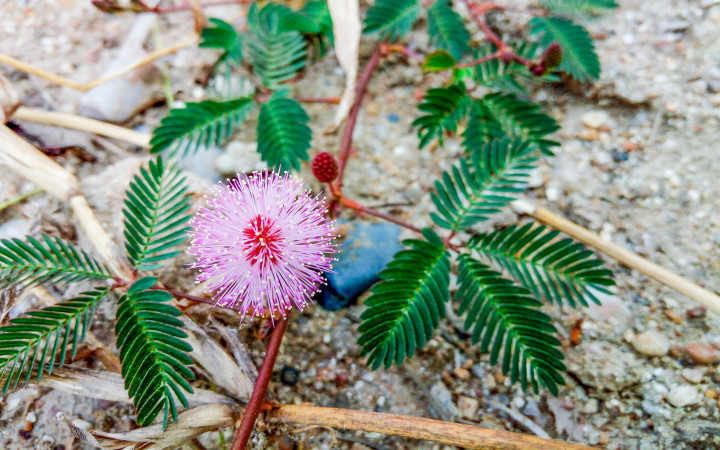Today’s Wonder of the Day was inspired by Zackary from Milwaukee. Zackary Wonders, “How does the Sensitive Plant work?” Thanks for WONDERing with us, Zackary!
Do you say hello by giving high fives? Some people shake hands or dap. In Spain, many people kiss both cheeks. In New Zealand, they bump noses! Cultures across the globe have different ways for people to greet one another. The goal of these actions is to make others feel welcome. However, many people would rather say hello verbally. We should always make sure we’re saying hello to people in ways that are comfortable for them. But what if the “other” isn’t a person? Lucky for us, even some plants tell us when they don’t like being touched!
The sensitive plant, whose scientific name is mimosa pudica, is also called the humble plant, shame plant, or the touch-me-not. It grows in Central and South America. Some people keep it as a houseplant because of its interesting behavior. When you touch the leaves of the sensitive plant, it releases water from its leaves and stalks. As water drains to the plant’s base, the leaves close and the stalks droop. This causes the plant to look wilted!
Why does the sensitive plant draw back from physical contact? Because it doesn’t want you to touch it, of course! Just like people, this plant sends physical signals that you should leave it alone.
This reaction to touch is a defense mechanism. Wouldn’t you be spooked if the food you were about to eat shied away from you? Many animals and insects eat plants, so the sensitive plant learned to move to scare away predators. Startled by the sudden wilting, hungry animals move away to find a different plant to eat. Additionally, wilted plants don’t look appetizing. This encourages other nearby predators to look for their dinner elsewhere.
The sensitive plant also closes up at night to save energy. In this, it’s not alone. Many other plants fold up their leaves at nighttime. At night, leaves are not taking in any energy from sunlight. Therefore, plants decide that holding their leaves open and their stalks straight is a waste of nutrients. Instead, the sensitive plant relaxes these extremities, much like going to sleep!
If you touch a sensitive plant and it wilts, have no fear! It’s still a healthy plant. After a few minutes, it will send water back to its leaves and stand straight up again. However, it takes a lot of time for the sensitive plant to rejuvenate itself. Don’t touch the plant just to watch it wilt. It may seem like fun, but it’s not fun for the sensitive plant.
It’s always important to pay attention to the body language of plants, animals, and other people! We should never want to make other living things uncomfortable, and especially not for our own entertainment. What signs do you give off when you’re uncomfortable? Remember what those signals are, and pay attention to them in others, even in plants!
Standards: NGSS.LS3.A, NGSS.LS3.B, NGSS.LS1.C, NGSS.LS1.A, CCRA.R.1, CCRA.R.2, CCRA.R.3, CCRA.W.2, CCRA.SL.1




